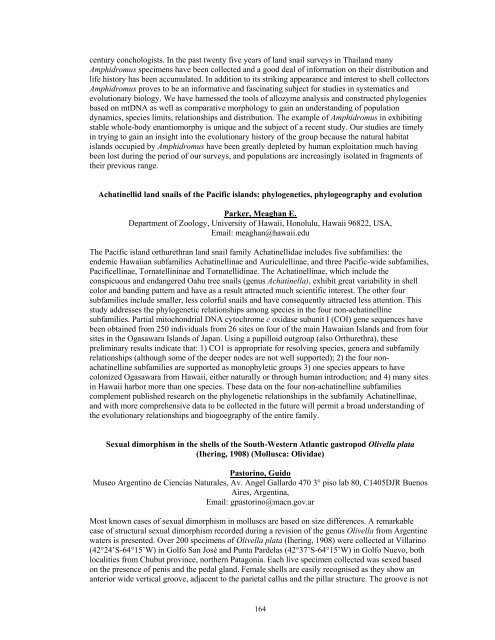World Congress of Malacology Antwerp ... - Unitas Malacologica
World Congress of Malacology Antwerp ... - Unitas Malacologica
World Congress of Malacology Antwerp ... - Unitas Malacologica
You also want an ePaper? Increase the reach of your titles
YUMPU automatically turns print PDFs into web optimized ePapers that Google loves.
century conchologists. In the past twenty five years <strong>of</strong> land snail surveys in Thailand many<br />
Amphidromus specimens have been collected and a good deal <strong>of</strong> information on their distribution and<br />
life history has been accumulated. In addition to its striking appearance and interest to shell collectors<br />
Amphidromus proves to be an informative and fascinating subject for studies in systematics and<br />
evolutionary biology. We have harnessed the tools <strong>of</strong> allozyme analysis and constructed phylogenies<br />
based on mtDNA as well as comparative morphology to gain an understanding <strong>of</strong> population<br />
dynamics, species limits, relationships and distribution. The example <strong>of</strong> Amphidromus in exhibiting<br />
stable whole-body enantiomorphy is unique and the subject <strong>of</strong> a recent study. Our studies are timely<br />
in trying to gain an insight into the evolutionary history <strong>of</strong> the group because the natural habitat<br />
islands occupied by Amphidromus have been greatly depleted by human exploitation much having<br />
been lost during the period <strong>of</strong> our surveys, and populations are increasingly isolated in fragments <strong>of</strong><br />
their previous range.<br />
Achatinellid land snails <strong>of</strong> the Pacific islands: phylogenetics, phylogeography and evolution<br />
Parker, Meaghan E.<br />
Department <strong>of</strong> Zoology, University <strong>of</strong> Hawaii, Honolulu, Hawaii 96822, USA,<br />
Email: meaghan@hawaii.edu<br />
The Pacific island orthurethran land snail family Achatinellidae includes five subfamilies: the<br />
endemic Hawaiian subfamilies Achatinellinae and Auriculellinae, and three Pacific-wide subfamilies,<br />
Pacificellinae, Tornatellininae and Tornatellidinae. The Achatinellinae, which include the<br />
conspicuous and endangered Oahu tree snails (genus Achatinella), exhibit great variability in shell<br />
color and banding pattern and have as a result attracted much scientific interest. The other four<br />
subfamilies include smaller, less colorful snails and have consequently attracted less attention. This<br />
study addresses the phylogenetic relationships among species in the four non-achatinelline<br />
subfamilies. Partial mitochondrial DNA cytochrome c oxidase subunit I (COI) gene sequences have<br />
been obtained from 250 individuals from 26 sites on four <strong>of</strong> the main Hawaiian Islands and from four<br />
sites in the Ogasawara Islands <strong>of</strong> Japan. Using a pupilloid outgroup (also Orthurethra), these<br />
preliminary results indicate that: 1) CO1 is appropriate for resolving species, genera and subfamily<br />
relationships (although some <strong>of</strong> the deeper nodes are not well supported); 2) the four nonachatinelline<br />
subfamilies are supported as monophyletic groups 3) one species appears to have<br />
colonized Ogasawara from Hawaii, either naturally or through human introduction; and 4) many sites<br />
in Hawaii harbor more than one species. These data on the four non-achatinelline subfamilies<br />
complement published research on the phylogenetic relationships in the subfamily Achatinellinae,<br />
and with more comprehensive data to be collected in the future will permit a broad understanding <strong>of</strong><br />
the evolutionary relationships and biogoegraphy <strong>of</strong> the entire family.<br />
Sexual dimorphism in the shells <strong>of</strong> the South-Western Atlantic gastropod Olivella plata<br />
(Ihering, 1908) (Mollusca: Olividae)<br />
Pastorino, Guido<br />
Museo Argentino de Ciencias Naturales, Av. Angel Gallardo 470 3° piso lab 80, C1405DJR Buenos<br />
Aires, Argentina,<br />
Email: gpastorino@macn.gov.ar<br />
Most known cases <strong>of</strong> sexual dimorphism in molluscs are based on size differences. A remarkable<br />
case <strong>of</strong> structural sexual dimorphism recorded during a revision <strong>of</strong> the genus Olivella from Argentine<br />
waters is presented. Over 200 specimens <strong>of</strong> Olivella plata (Ihering, 1908) were collected at Villarino<br />
(42°24’S-64°15’W) in Golfo San José and Punta Pardelas (42°37’S-64°15’W) in Golfo Nuevo, both<br />
localities from Chubut province, northern Patagonia. Each live specimen collected was sexed based<br />
on the presence <strong>of</strong> penis and the pedal gland. Female shells are easily recognised as they show an<br />
anterior wide vertical groove, adjacent to the parietal callus and the pillar structure. The groove is not<br />
164



